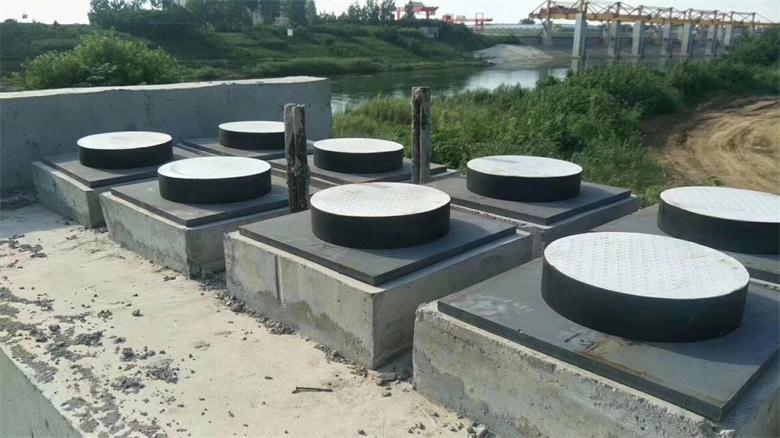Laminated elastomeric bridge bearings are precision-engineered components fabricated through a multi-stage industrial process:
1.Layer Assembly: Alternating vulcanized rubber sheets (NR/SBR/CR compounds, 5-15mm thickness) and cold-rolled steel plates (Q235/Q345 grade, 2-8mm thickness) are bonded under controlled pressure.
2.Vulcanization: Thermochemical curing at 140-160°C for 60-120 minutes ensures molecular cross-linking between rubber and steel interfaces (adhesion strength ≥7 MPa per GB/T 7760).
3.Post-Processing: Surface PTFE coating (0.5-2mm) or stainless steel sliding plates are added for low-friction applications.

Property | Technical Specification | Test Standard |
Vertical Stiffness (Kv) | 1,500-3,500 kN/mm (axial load ≤70 MPa) | ISO 22762-1 |
Shear Modulus (G) | 0.8-1.2 MPa (±50% shear strain at 23°C) | EN 1337-3 Annex B |
Rotation Capacity | 0.02-0.04 radians (bridge deck slope ≤6%) | AASHTO LRFD 14.4.1 |
Compressive Deflection | ≤15% of total height under design load | JTG/T J22-2008 |
Competitive Advantages vs. Rigid Bearings
1. Structural Adaptability
Thermal Compensation: Accommodates ±50mm longitudinal displacement per 100m span (ΔT=±35°C).
Multi-Axial Deformation: Simultaneously resolves bending moments (≤15 kN·m) and torsional stresses in curved/skewed bridges (radius ≥150m, skew angles 10°-60°).
2. Durability & Maintenance
Service Life: 50+ years with ≤0.5mm/year rubber aging rate (indoor accelerated aging test per GB/T 3512).
Zero Lubrication: Self-compensating wear resistance (PTFE-steel friction coefficient μ=0.03-0.08).
3. Dynamic Performance
Vibration Damping: Reduces peak vehicle-induced vibrations by 40-60% (frequency range 5-30 Hz).
Seismic Isolation: Effective up to PGA=0.3g ground motion (Zone II seismic design per GB 18306).
The impact of bridge structures and piers extends the service life of bridges. Therefore, laminated rubber bearings are popular in the bridge industry for large, medium, and small spans
It is widely used in highway bridges and urban elevated bridges.
Mechanical Advantages of Laminated Rubber Bearings with PTFE Sliding Plates
Laminated rubber bearings exhibit superior elasticity, recovery capacity, and mechanical performance under load compared to conventional rubber bearings. Their durability is enhanced by embedded steel plates, enabling long-term structural stability in construction applications. A specialized variant—PTFE sliding rubber bearings—incorporates a polytetrafluoroethylene (PTFE) layer to reduce friction, significantly altering their performance characteristics. Investigating the effects of natural corrosion on the mechanical properties of PTFE sliding rubber bearings holds critical engineering relevance.
Research Scope: Corrosion Impact on PTFE Sliding Rubber Bearings
This study evaluates the mechanical performance of highway bridge PTFE sliding rubber bearings under seven environmental conditions:
① Freeze-thaw cycles
② Salt freeze
③ Acid corrosion
④ Thermal aging
⑤ Hygrothermal exposure
⑥ Nitric acid immersion
⑦ Nitrosulfuric acid immersion

Post-accelerated corrosion treatment, the bearings undergo:
Axial compression tests: Analyzing dimensional stability, compressive modulus, and failure thresholds.
Shear resistance tests: Measuring shear stiffness degradation and ultimate shear strain.
Freeze-Thaw Cycling Test Study
In northern regions characterized by extremely low winter temperatures and frequent snowfall, daily midday freeze-thaw cycles can cause significant structural damage to rubber bearings. To systematically evaluate the mechanical performance degradation of PTFE sliding rubber bearings under freeze-thaw conditions, this study designed multi-gradient cyclic tests:
Test Protocol: Specimens underwent 25, 50, 75, 100, and 150 standardized freeze-thaw cycles (ASTM C666/C666M)
Validation confirmed alignment with 100-year service life predictions.Engineering Value: Established quantitative relationships between freeze-thaw cycles and load-bearing capacity degradation, informing cold-region bridge bearing selection.
Salt Freeze Corrosion Test Study
Coastal/river-crossing bridges, as critical infrastructure, face dual corrosion risks from chloride ions (Cl⁻) in marine environments affecting both concrete and seismic isolation bearings. This research investigates coupled salt-freeze effects on PTFE sliding bearings:Accelerated Corrosion Method: Simulated seawater immersion using 3.5% NaCl solution, with cyclic salt-freeze treatment (-20°C ±2°C) for 20, 40, 60, 80, and 100 days.Performance Metrics: Quantified via:Axial compression tests (EN 1337-3): Thickness variation rate (≤5% compliance threshold)Shear tests (ISO 22762-1): Nonlinear degradation of shear stiffness
Mechano chemical Findings: Revealed PTFE layer friction coefficient escalation (μ increased from 0.05 to 0.12) due to chloride infiltration, guiding maintenance schedules for marine bridges.
Sulfuric Acid Corrosion, Nitric Acid Corrosion, and Sulfuric-Nitric Acid Corrosion:
Among the three major global acid rain zones in Europe, America, and Asia, the severe acid rain zone (pH<4.5) covers the largest area. The region south of the Yangtze River in China stands as the world's most intense acid rain center. This has driven our comprehensive research on the mechanical properties of rubber bearings under sulfuric acid corrosion, nitric acid corrosion, and sulfuric-nitric acid corrosion conditions.
Thermal Corrosion Testing:
With the continuous rise in global temperatures, high-temperature periods now occupy an increasingly prolonged proportion of annual weather patterns across China. As is well documented, rubber undergoes thermal aging when exposed to heat, manifesting as localized cracking. This phenomenon not only compromises the service life of rubber bearings but also creates challenges for long-term bridge durability, maintenance, and reinforcement. Consequently, investigating thermal corrosion's impact on rubber bearings' mechanical properties becomes critical. Furthermore, rubber bearings operate under combined environmental stresses rather than isolated thermal effects. Heat exposure can accelerate the degradation caused by other factors, potentially creating synergistic effects more severe than individual stressors acting alone. Therefore, understanding the isolated thermal corrosion mechanism serves as the essential foundation for studying complex multi-factor interactions. This underscores the necessity for in-depth thermal corrosion research.
Hydrothermal Corrosion Testing:
Hydrothermal corrosion represents a highly aggressive degradation mechanism driven by the synergistic effects of humidity and temperature. Under thermal stress, PTFE sliding rubber bearings undergo thermal aging (commonly termed thermal degradation), manifesting as micro-cracks on their surfaces and sidewalls. Humidity, acting through vapor-phase penetration, gradually infiltrates these micro-cracks over prolonged exposure, accelerating thermal corrosion by expanding the material's vulnerable contact area. Crucially, moisture and heat exhibit mutually reinforcing mechanisms: moisture amplifies thermal degradation, while heat intensifies moisture permeation.
To investigate hydrothermal effects on the mechanical properties of PTFE sliding bearings, we conducted comparative experiments focusing on axial compression performance. By analyzing test data under controlled humidity-temperature cycles, we derived actionable conclusions to optimize engineering applications of PTFE-based components in harsh environmental conditions.